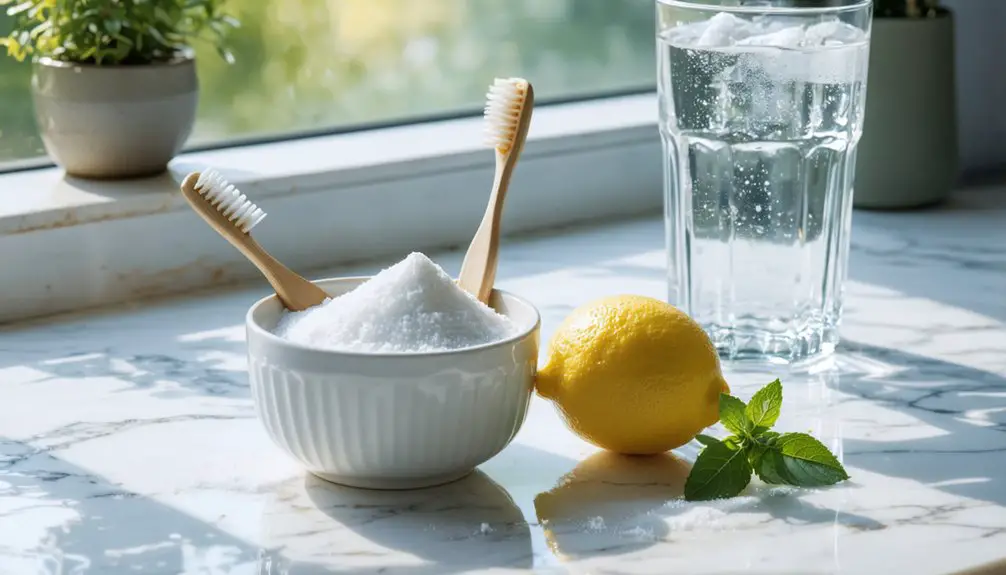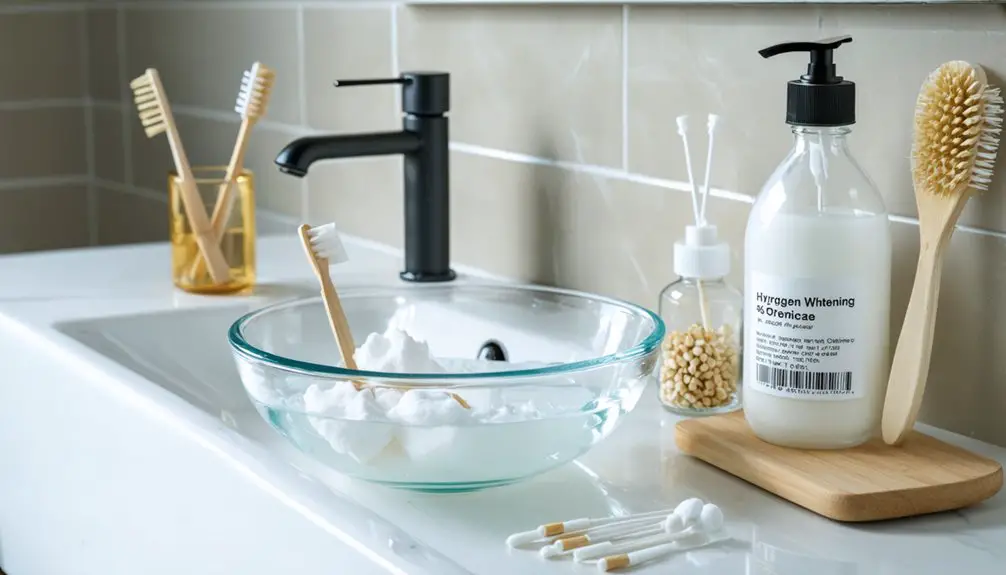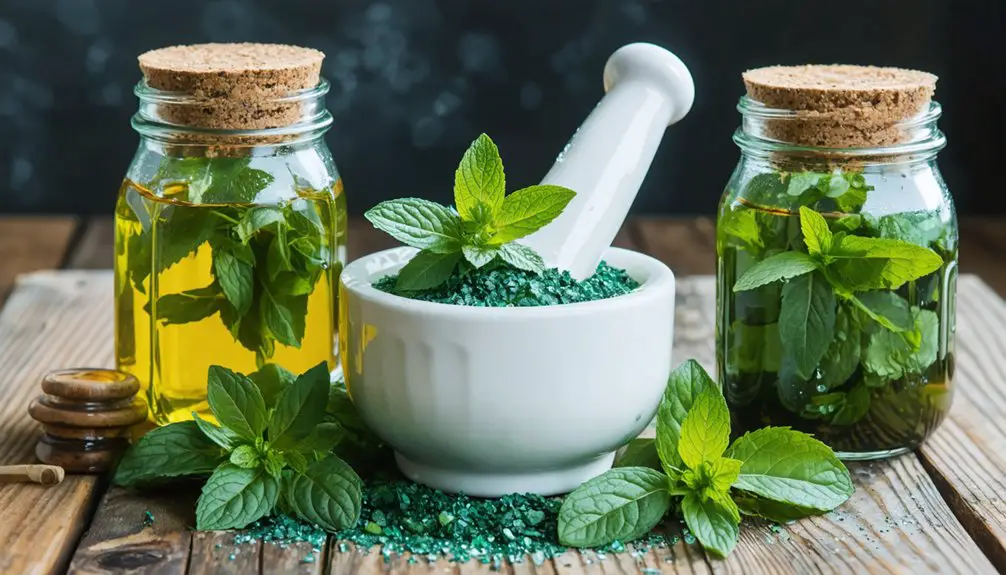You can safely whiten your teeth with baking soda by creating a smooth paste using equal parts baking soda and water. Apply this mixture gently with a soft-bristled toothbrush 1-2 times weekly for 2 minutes, followed by thorough rinsing. For enhanced results, combine baking soda with hydrogen peroxide in a 1:2 ratio. While basic mixtures work well, proper technique and consistency are essential for achieving ideal whitening without damaging your enamel. The following methods will help you maximize your results while protecting your dental health.
Key Takeaways
- Mix equal parts baking soda and water to create a smooth paste, applying with gentle circular motions for 2 minutes.
- Combine one part baking soda with two parts hydrogen peroxide for enhanced whitening effectiveness and better results.
- Use baking soda and coconut oil in equal portions, adding essential oils for flavor while maintaining gentle abrasive properties.
- Limit application to once or twice weekly, always following with fluoride toothpaste to protect enamel health.
- Brush gently with a soft-bristled toothbrush and rinse thoroughly, monitoring for any tooth sensitivity.
Understanding How Baking Soda Whitens Teeth
While many people turn to baking soda for natural teeth whitening, understanding its chemical properties helps explain how it actually works.
Baking soda’s chemistry revolves around its nature as a mild base that can neutralize both acids and bases in your mouth. Its soft crystal structure dissolves easily in water, allowing it to reach difficult spots between teeth while maintaining enamel safety through gentle abrasion. Professional-grade products containing peroxide-based bleach may be needed for more dramatic whitening results.
Thanks to its mild base properties and gentle crystal structure, baking soda safely cleans teeth while reaching deep between them.
You’ll find that baking soda works primarily as a mechanical stain remover, polishing away surface discoloration without damaging your tooth structure. It’s actually softer than your tooth enamel, making it safer than many commercial whitening products. When used properly, twice per week treatment helps maintain optimal whitening results.
The alkaline properties also help neutralize acid-producing bacteria that can cause staining, while its antibacterial effects reduce plaque buildup that dulls teeth’s appearance.
Safe Application Techniques for Maximum Results
Success with baking soda teeth whitening depends heavily on proper application techniques and safety protocols. To achieve ideal results while protecting your enamel, limit application frequency to 1-2 times weekly and create the right paste consistency by mixing baking soda with water until smooth.
Use a soft-bristled toothbrush and apply the mixture using gentle circular motions for two minutes. Don’t scrub aggressively, as this can damage your enamel. After brushing, rinse thoroughly and follow with your regular fluoride toothpaste. The American Dental Association confirms that baking soda is safe for both enamel and dentin when used properly. Most users begin seeing surface stain reduction within the first few days of consistent use.
You’ll want to monitor for any sensitivity and discontinue use if irritation occurs. For enhanced whitening effects, you can carefully combine baking soda with mild hydrogen peroxide, but avoid harsh chemicals.
Remember to maintain your regular dental hygiene routine and consult your dentist before starting this whitening method.
Creating Effective Baking Soda Mixtures at Home
Creating effective baking soda whitening mixtures requires understanding the proper ratios and combinations of ingredients for ideal results.
You’ll find several proven mixing techniques that can help you achieve professional-quality whitening solutions at home.
Start with basic baking soda ratios: combine equal parts baking soda and water for a simple yet effective paste. For enhanced whitening, mix one part baking soda with two parts hydrogen peroxide.
If you’re using apple cider vinegar, maintain a 2:1 vinegar-to-baking-soda ratio. When creating a coconut oil-based mixture, blend equal portions with baking soda and add essential oils for flavor.
Remember to measure ingredients precisely and mix thoroughly until achieving a consistent texture. Since nearly all people value a bright smile as a social asset, these natural whitening solutions offer an accessible option.
These carefully balanced combinations guarantee peak whitening while protecting your enamel from excessive abrasion. The mild abrasive properties of baking soda help remove surface stains effectively without damaging tooth structure.
Common Mistakes to Avoid When Using Baking Soda
Even with proper mixing ratios, baking soda teeth whitening can lead to serious dental problems when not used correctly. To protect your enamel and avoid common baking soda dangers, don’t brush aggressively or use it more than twice weekly. Regular use beyond this frequency can cause permanent enamel erosion. Creating a proper paste-like consistency requires mixing half-teaspoon of baking soda with 1-2 teaspoons of water.
Never combine baking soda with acidic ingredients like lemon juice or vinegar, as this creates a highly abrasive mixture that can permanently damage your teeth.
Don’t make the mistake of replacing your regular toothpaste with baking soda, as you’ll miss out on essential fluoride and antibacterial protection.
If you have braces, sensitive teeth, or existing dental conditions, consult your dentist before using baking soda whitening methods.
Remember to rinse thoroughly after each use and avoid leaving the mixture on your teeth for extended periods.
Combining Baking Soda With Other Natural Whiteners
While baking soda alone can brighten your smile, combining it with other natural whiteners can enhance its effectiveness and provide additional oral health benefits.
Mixing baking soda with hydrogen peroxide creates a powerful whitening paste that’s clinically supported when used once or twice weekly. You can also dilute this combination into a mouthwash for antibacterial effects.
For sensitive teeth, try combining baking soda with water for gentler stain removal. If you’re interested in oil pulling, blend baking soda with coconut oil for added plaque control. The mixture is highly affordable and readily available in most stores.
While some suggest mixing baking soda with strawberry mixture or activated charcoal, these methods lack scientific backing and may risk enamel damage. Natural whitening methods often require prolonged regular use for minimal visible results. Stick to proven combinations, and always follow proper dilution ratios to protect your teeth’s long-term health.
Maintaining Long-Term Results and Dental Health
Achieving long-term teeth whitening results with baking soda requires careful attention to frequency and technique.
For lasting whitening with baking soda, monitor both how often and how carefully you apply it to protect your smile.
You’ll need to balance consistent use with enamel protection to avoid irreversible damage. Monitor your teeth for increased sensitivity, and if it occurs, reduce application frequency or consult your dentist.
For best results, combine your baking soda whitening routine with proper oral hygiene practices. Use fluoride toothpaste regularly, and consider periodic fluoride treatments for sensitivity management.
Don’t mix baking soda with acidic substances, as this can harm your enamel. Instead, use a soft-bristled brush and gentle pressure when applying the mixture.
Remember that baking soda mainly removes surface stains. For deeper discoloration, you may need to explore professional whitening options while maintaining your dental health through regular checkups.
Scientific Evidence Behind Baking Soda Whitening
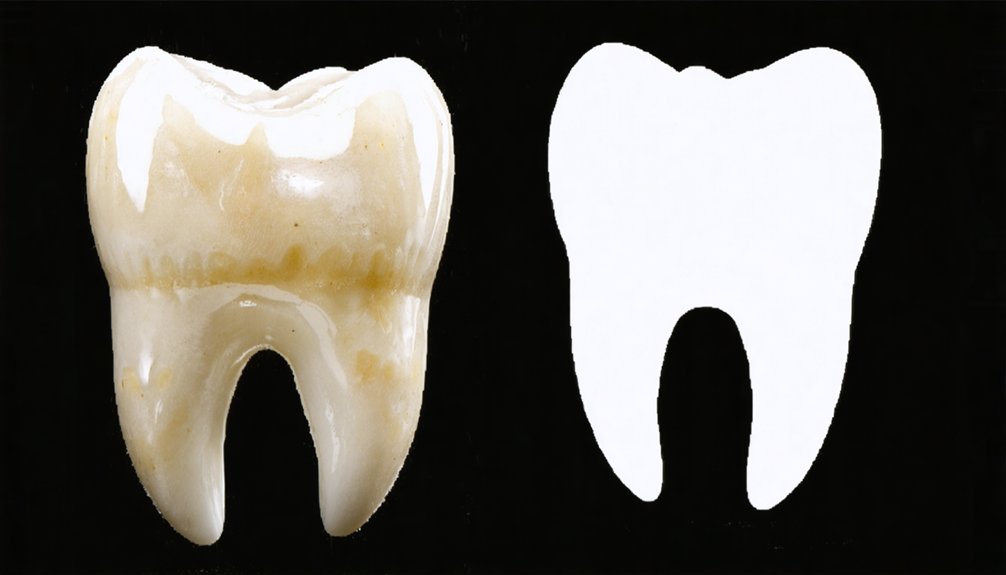
You’ll find strong scientific backing for baking soda’s teeth whitening capabilities through extensive laboratory testing and clinical research.
Studies consistently show that baking soda’s gentle abrasive action effectively removes surface stains while its alkaline properties help neutralize harmful acids in your mouth.
Clinical trials demonstrate that baking soda outperforms standard non-bleaching toothpastes for stain removal, though it’s less potent than peroxide-based professional treatments.
Laboratory Studies Results
Multiple laboratory studies have confirmed baking soda’s effectiveness as a mild abrasive agent for tooth whitening.
Laboratory testing shows that when combined with hydrogen peroxide, baking soda creates a whitening paste that effectively removes surface stains without damaging tooth enamel. The whitening efficacy increases through baking soda’s dual action of mechanical stain removal and pH balancing properties.
- Crystalline structure allows penetration into hard-to-reach areas
- Forms an effective whitening paste when mixed with hydrogen peroxide
- Neutralizes acidic conditions that contribute to staining
- Demonstrates superior stain removal compared to standard toothpastes
- Requires consistent application over several weeks for best results
While results vary based on stain type and severity, research confirms that baking soda-based solutions outperform conventional dentifrices in controlled laboratory environments.
Clinical Research Analysis
Beyond laboratory findings, extensive clinical research validates baking soda’s effectiveness for teeth whitening. Clinical trials show that baking soda dentifrices considerably reduce tooth discoloration, with measurable improvements in just 4-6 weeks of use.
You’ll find that baking soda benefits include gentle yet effective stain removal without compromising enamel safety.
Research confirms baking soda’s mild abrasive action effectively removes surface stains while being gentler than many alternative whitening products. You can trust its safety profile, as studies report no considerable adverse effects with regular twice-daily use.
The alkaline nature of baking soda helps neutralize harmful mouth acids, potentially protecting your enamel from demineralization. While it won’t change intrinsic tooth color like peroxide-based treatments, you’ll notice lasting stain-prevention effects that can persist for weeks after use.
Professional Recommendations and Safety Guidelines
While baking soda offers an affordable teeth whitening solution, dental professionals emphasize following specific safety guidelines to protect your enamel.
Understanding both baking soda benefits and baking soda risks is vital for safe, effective whitening.
- Limit applications to once or twice weekly to prevent enamel erosion and sensitivity
- Use a small amount mixed with hydrogen peroxide or water, never acidic substances like lemon juice
- Apply the mixture gently for no more than 2 minutes, followed by thorough rinsing
- Continue using fluoride toothpaste alongside baking soda treatments for cavity protection
- Consider professionally formulated baking soda toothpaste as a safer alternative to homemade mixtures
Alternative Methods When Baking Soda Isn’t Suitable
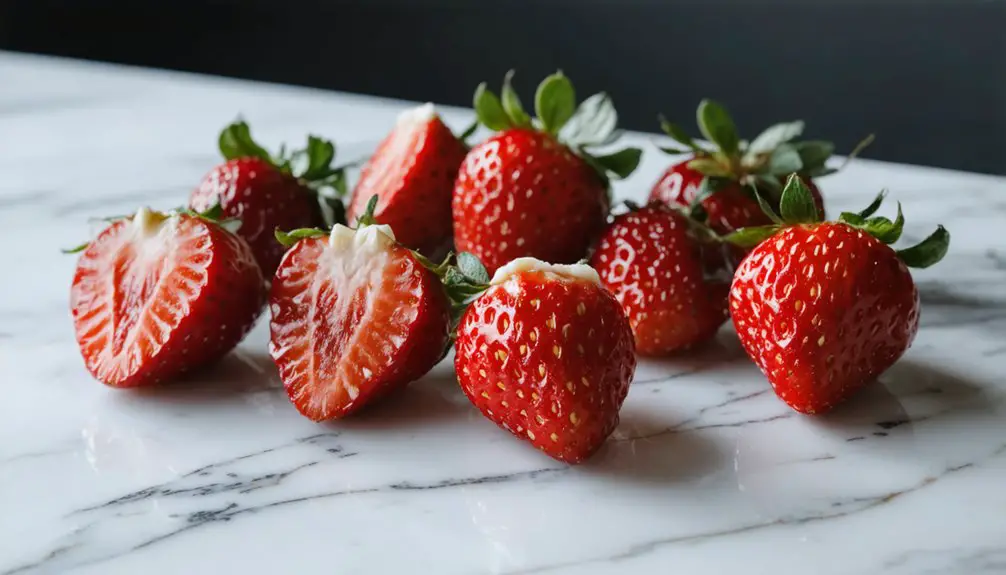
If you find that baking soda isn’t suitable for your teeth whitening needs, you’ll discover several proven alternatives ranging from professional treatments to natural methods.
You can explore dentist-supervised options like laser whitening or custom-fitted trays for maximum effectiveness, or consider gentler approaches like oil pulling with coconut oil and whitening toothpastes for gradual results.
While professional treatments offer the most dramatic results, natural alternatives like dietary adjustments and appropriate commercial products can help you achieve a brighter smile while protecting your enamel.
Professional Whitening Treatments
Although baking soda offers a budget-friendly whitening solution, professional treatments provide considerably more powerful and precise results for those seeking dramatic smile improvements.
Professional techniques like laser whitening, LED-activated systems, and Zoom treatments can improve tooth color by up to 8 shades in a single visit, demonstrating superior whitening efficacy compared to home remedies.
Consider these advantages of professional whitening:
- Results can last 1-3 years with proper maintenance
- Higher concentrations of peroxide deliver faster outcomes
- Customized treatment plans address individual needs
- Expert supervision guarantees safety and peak results
- Advanced technology allows adjustable intensities for sensitive teeth
While professional treatments require a higher initial investment, they often prove more cost-effective long-term by delivering lasting results under careful dental supervision.
Natural Whitening Alternatives
Several natural alternatives to baking soda offer gentler teeth whitening options for those with sensitive teeth or concerns about abrasiveness.
Oil pulling with coconut oil provides a safe daily practice that can reduce bacteria and plaque while gradually improving tooth appearance. You’ll need to swish one tablespoon for 15-20 minutes for best results.
Natural fruit remedies like strawberries contain malic acid that helps break down surface stains, though you should limit use to avoid enamel damage.
Crunchy vegetables and nuts provide mechanical cleaning through regular chewing, while maintaining enamel integrity.
For a more intensive approach, activated charcoal can bind to surface stains, but don’t use it more than twice weekly.
Always avoid highly acidic natural products like vinegar or lemon juice, as these can permanently weaken your enamel.
Commercial At-Home Solutions
When baking soda proves too abrasive or ineffective, commercial at-home whitening solutions offer scientifically-proven alternatives with varying strengths and application methods.
Consumer preferences have evolved, leading to diverse commercial products that cater to different needs and sensitivity levels.
- Over-the-counter whitening gels containing up to 10% hydrogen peroxide provide gradual results over 1-2 weeks.
- Custom-fit trays from dental professionals offer controlled application of stronger peroxide concentrations.
- Chemical whitening toothpastes use specialized abrasives and compounds for enhanced stain removal.
- Light-activated systems combine peroxide gels with LED technology for accelerated results.
- Professional take-home kits deliver stronger formulations while maintaining safety through dentist supervision.
These solutions incorporate desensitizing agents and pH balancers to protect your enamel while achieving noticeable whitening results with consistent use.
Frequently Asked Questions
Can Baking Soda Whiten Teeth That Have Been Stained by Medications?
You won’t see significant improvement using baking soda on medication-stained teeth since these stains affect deeper tooth layers. For intrinsic medication effects, you’ll need professional dental treatments like bleaching or veneers.
Does Baking Soda Teeth Whitening Work Differently on Crowns and Veneers?
Unlike your natural teeth, you’ll find baking soda won’t whiten crowns or veneers since they’re made of non-porous materials. Excessive use could affect your crowns’ longevity and increase veneers’ sensitivity.
How Long Should I Wait After Eating Before Using Baking Soda?
You’ll need to wait at least 2-4 hours after eating before using baking soda, as this recommended waiting period allows proper digestion and minimizes eating impact on your teeth’s acid balance.
Can Children Safely Use Baking Soda for Teeth Whitening?
Like Sarah’s mom, you’ll want to consult your child’s dentist first. While baking soda is generally safe for children’s dental health, occasional supervised use is best to protect their delicate tooth enamel.
Will Baking Soda Whitening Affect the Bonding Material Used for Braces?
You shouldn’t use baking soda while wearing braces, as it may compromise braces maintenance and dental safety by potentially weakening the bonding materials that hold your brackets in place.
References
- https://southeasterndentalcenter.com/baking-soda-a-natural-solution-for-whiter-teeth/
- https://ubiehealth.com/doctors-note/baking-soda-teeth-whitening-effectiveness
- https://www.healthline.com/health/baking-soda-toothpaste
- https://pmc.ncbi.nlm.nih.gov/articles/PMC10024105/
- https://pubmed.ncbi.nlm.nih.gov/29056186/
- https://www.armandhammer.com/en/articles/how-to-whiten-teeth-with-baking-soda
- https://health.howstuffworks.com/wellness/oral-care/products/does-baking-soda-whiten-teeth.htm
- https://www.sensodyne.com/en-us/oral-health-tips/whitening-sensitive-teeth/can-baking-soda-whiten-teeth/
- https://www.youtube.com/watch?v=2uptserNzAs
- https://www.smilesofcary.com/how-to-whiten-teeth-with-baking-soda-dentist-cary-raleigh
